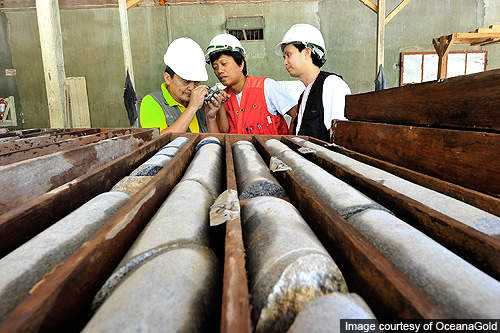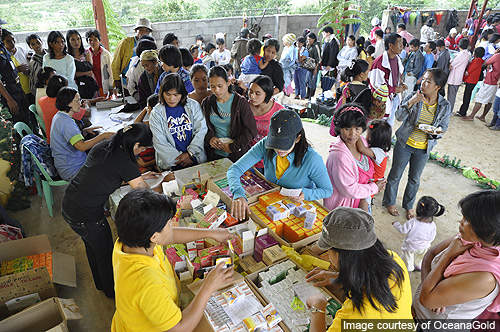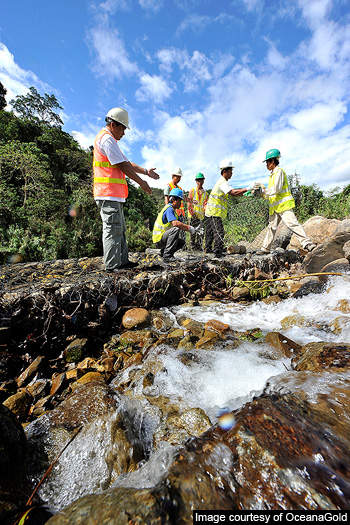The Didipio project is a high grade gold-copper mine development, located approximately 270km north-east of Manila in the Philippines. Owned by OceanaGold, the mine is forecasted to produce 71koz of gold (Au) and 15kt of copper (Cu) over its projected 16-year mine life. The project was put on care and maintenance in 2008, following cost related issues.
A comprehensive re-optimisation study of the project, in September 2010, suggested an initial open pit transition to an underground mine. The company has raised C$115m for the project development. Pre-construction activities began in the first quarter of 2011 and actual construction began in June 2011. The project commissioning is slated for the last quarter of 2012.
Reserves
The mine contains 29.72mt of proven and probable reserves grading at 1.48 g/t Au and 0.57% Cu. The combined measured and indicated resources amount to 60.07mt grading at 1.03g/t Au and 0.45% Cu. Inferred resources have been estimated at 21.2mt graded at 0.5g/t Au and 0.26% Cu.
Geology
The deposit lies within the Dinkidi stock in the Didipio Igneous Complex, a massive alkalic intrusive body. Regionally, the geology consists of late Miocene aged volcanic, volcaniclastic, intrusive and sedimentary rocks that are hosted above a sequence of pre-tertiary aged tonalite and schist.
The deposit is elliptical in shape with a pipe like vertical plunge, measuring 450m in length, 150m in width and between 800m and 1,000m in depth.
The youngest phase of the composite stock includes leucocratic quartz-monzonite porphyry known as Quan Porphyry. At its core, the Quan Porphyry grades into a crystal clustered quartz syenite known as Bufu Felsite.
The local geology is characterised by a steep east dipping composite microdiorite intrusive with a north-north-west trend. The intrusive has a contact with the volcaniclastics of the Mamparang formation. The zone is intruded by north-north-west-striking local magnetic lineament that represents a possible major strike-slip faulting. The faults are believed to have acted as major controls for the positioning and elongation of porphyry deposits in the region.
Porphyry style mineralisation is related with a K-feldspar alteration zone that occurs within a small intrusive composite porphyritic monzonite stock within the core of the Dark Diorite. The alteration is defined in extent by the 400m-long Didipio Ridge, the only surface expression of the deposit that rises 100m steeply above the valley.
Mineralisation
Mineralisation occurs within a composite multiphase monzonite stock that is intruded by an 800m-long and 200m-wide equigranular biotite monzonite known as the Tunja Monzonite. Gold and copper mineralisation is predominately hosted within the Tunja Monzonite that intrudes the Dark Diorite. The Tunja Monzonite is intruded by the Balut Dyke, a highly mineralised, differently textured clinopyroxene-syenite that measures between 10m and 30m in width.
Mining and processing
Mining activities are scheduled to commence in January 2012. Open cut mining will be conducted for the initial six years of operation and will later proceed to underground mining from 2020. It will be carried out using standard drill and blast technique. The pit will be 150m deep. The ore will be loaded into haul trucks by hydraulic excavators.
Underground mining will be by sublevel open stoping with cemented paste fill. Ore will be hauled up a decline in diesel truck loaded by diesel loaders.
The proposed processing plant will operate at a design capacity of 2.5mtpa. The primary open circuit crushing plant will reduce the ore size to 125mm. The coarsely crushed ore will be delivered through a transfer bin to the SAG mill. The SAG and ball mill discharge will be sent for classification to the hydrocyclones.
The fines will be delivered to flotation while the coarse material will be returned to a closed circuit ball mill. The concentrate will be sent to a Falcon-type gravity concentrator. The gravity concentrate will be further concentrated using a shaking table. Following additional treatment, the concentrates will be smelted into doré bars.
Contracts
The contract for the project’s engineering, design and procurement was awarded to Ausenco. Ausenco’s scope of work includes the processing plant, related infrastructure, site preparation, earthworks, site road and other facilities.
Ausenco will also procure major equipment packages and construction material required for the processing plant, an accommodation camp and site infrastructure.
Leighton Asia won the first phase mining contract valued at $60m. The contractor will also be responsible for the construction of accommodation camps, tailing storage facility and related earth works.






